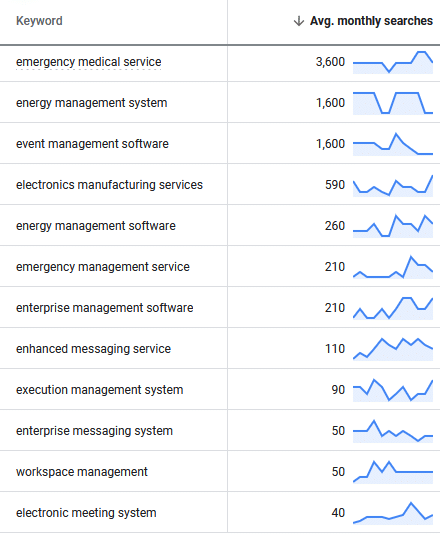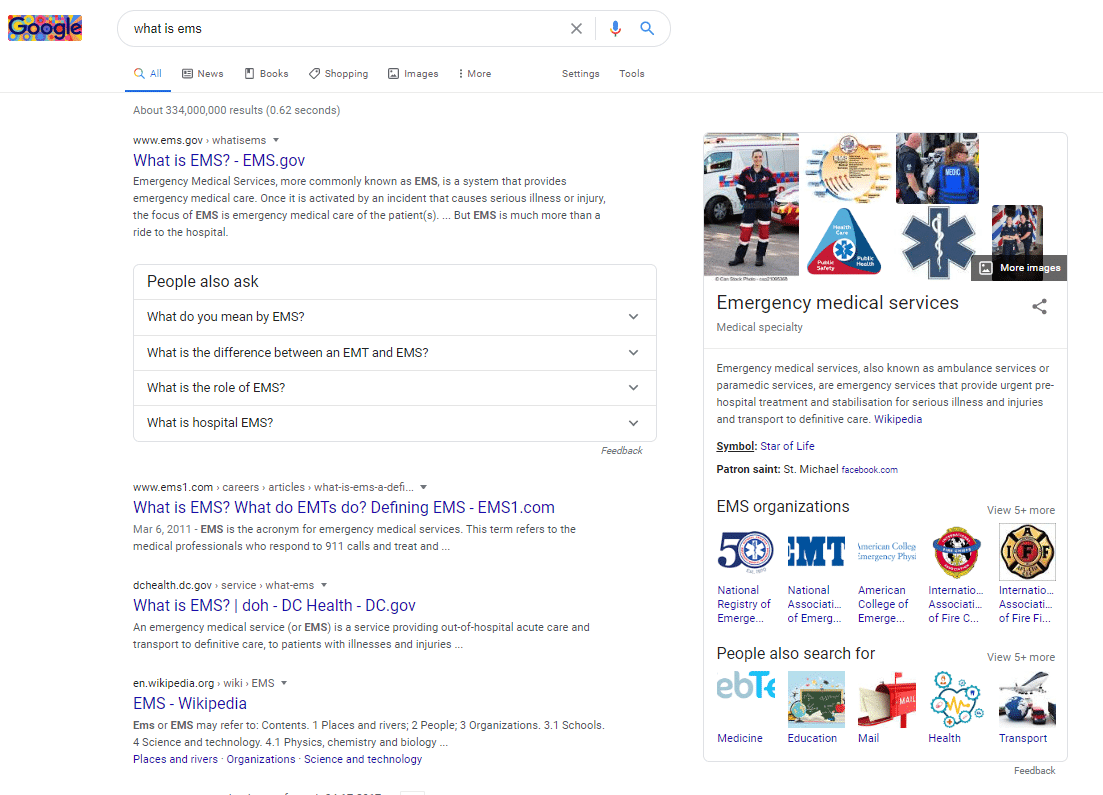
There’s a lot of confusion around what EMS Software is. Just the term “EMS” can mean many things. In Wikipedia, “EMS” stands for 50+ different things, ranging from people and organizations to science and computer. In abbreviations.com, “EMS” stands for 100+ terms.
Plus, there’s even a company called EMS Software, a provider of workplace and campus management platform.
We think EMS software should stand for Emergency Medical Services (EMS) Software, or software for ambulance services. We will show you why we think that way when we explore the top definitions of “EMS Software” in the following section. Then, we dive into the details of Emergency Medical Services (EMS) software, including its business impact, key features, and the problems with most EMS software.
Top 3 “EMS Software” Definitions
Here’s how I selected the top 3 “EMS Software” definitions. From the 100+ terms on abbreviations.com and the 50+ terms on Wikipedia, I selected the terms where it made sense to build a software for. (Below are the terms.) For example, EMS that refers to people, organization, or slangs such as “Earn Money Sleeping” are omitted.
Next, I placed those terms into Google Ads to check their search volume. Here are the results:

Here are the definitions of the top 3 “EMS”:
#1: Emergency Medical Service Software
This refers to software built for Emergency Medical Service providers, exactly what Traumasoft develops and markets. These organizations include first responders performing ambulance or wheelchair services, for emergency or non-emergency use.
#2: Energy Management System/Software
This is a system used by electric utility grid operators. The purpose is to monitor, control and optimize energy consuming devices. These devices include heating and cooling equipment, fans, pumps, and others. The goal is to control and reduce an organization’s energy consumption and reduce cost.
#3: Event Management Software
This software is mainly used by event planners, intended to minimize administrative effort by reducing the steps to manage a meeting or an event. Using the software has proven to increase attendance, productivity, and profit margin. This is one of the software tools that EMS Software, LLC provides.
***
Although all of the above can be correctly referred to as “EMS software”, we think that the term EMS Software should really stand for Emergency Medical Services Software for the reasons below.
Why EMS Software Should be Known as Emergency Medical Services Software
First, Emergency Medical Services has the highest search volume among all EMS terms. Although search volume doesn’t justify this by default, having a crystal-clear definition does save people a lot of confusion.
Second, it’s because Google agrees with us. If you simply search for “what is EMS”, the top 3 search results all refer to Emergency Medical Services.

Third, top software review sites like Capterra and G2.com refer to EMS software as Emergency Medical Services software. Their decision to make this association could be due to the first two reasons mentioned here, by popular demand and/or based on their experience.
The Goals, Benefits and Business Value of Emergency Medical Service Software
The goals, benefits and business values of EMS software are to increase efficiency, eliminate information error, and reduce cost. That means the software should automate and streamline internal processes to track, manage and analyze what is happening across all functions of the company.
As a result, staff can do more with less time, helping providers achieve more with higher quality and less resources. Specifically, this translates to:
Calculating and Optimizing Workload – The software should be able to offer actionable insights and make it easy for the dispatchers to schedule and manage personnel workload efficiently.
Ensure Better and Timely Patient Care – Efficient workload and scheduling, along with electronic patient care reporting (ePCR) for better record keeping, enables EMS organizations to provide improved, timely patient care.
Simplify Internal Processes Such as Billing – Take billing as an example. The software should improve financial regulatory compliance and reduce risk, while increasing efficiency and eliminating billing errors. This means the EMS software should have the ability to integrate with your clearinghouse, insurance, payroll and human resources.
Manage Personnel, Assets and Resources Efficiently – From human resources and payroll to vehicle maintenance and GPS tracking, the EMS software should make it simple to manage and maintain all your resources efficiently.
Key Features and Modules in Emergency Medical Services (EMS) Software
Computer-Aided Dispatch System
This feature decreases response times and improves resource utilization. It helps the dispatcher deliver timely call intakes and easily identify the status and location of responders in the field, and effectively dispatch responder personnel. The feature normally comes with a visual calendar or grid view filled with time slots that show the status and schedule of the responders.
To help dispatchers respond to calls efficiently, the feature should have a way to easily fill the available slots and update existing slots. For instance, Traumasoft’s CAD system uses a drag and drop feature to help dispatchers react immediately to changing conditions. To help dispatchers make deployment decisions, Traumasoft’s CAD system analyzes personnel, vehicle location, transporting status, and anticipated travel time.
Some CAD systems provide GPS integration that allows for real-time ETA’s, which enables timely patient care. With Traumasoft, ETA’s for incoming patients can be communicated to facilities via automated calls, ensuring improved patient care.
Personnel Management & Scheduling
EMS software should provide an easy way to track personnel time-off requests, availability, shift pickups and substitutions, and other data. This feature is both used by employees and management. Personnel can log in and view their own schedules, trade shifts with other personnel, and make time-off requests for managers to approve. The data that both employees and managers see are always in real-time, therefore eliminating errors and conflicts in scheduling.
At Traumasoft, we take scheduling to the next level, where EMS crew schedules are developed based on recent or seasonal call volume. Based on preset rules and configurations, these schedules are automatically generated. Managers simply review and approve the schedule, therefore maximizing utilization and resource allocation.
Billing
This feature should make the billing process easier, not more complex. That means accuracy, integration and automation are essential.
EMS software should have the ability to automate billing workflow so claims are handled properly. To lower rejection rates, it should give you control over insurance claims and review patient care reports for completeness, accuracy and compliance. Payments and invoices should be tracked easily and issues identified automatically.
Traumasoft’s billing functionality instantly verifies a patient’s insurance benefits and makes the appropriate billing adjustments. Claims are filed instantly with real-time processing for faster reimbursements. Traumasoft integrates with more than 8 of the most popular billing clearinghouses and can be used as your single source of truth for billing.
Electronic Patient Care Reporting (ePCR)
Electronic Patient Care Reporting (ePCR) is a standard industry practice for EMS organizations to record all patient data electronically. The goal is to simplify the collection and transfer of those records with speed and accuracy.
The EMS software should have the ability to transfer ePCR records for both external and internal use. External users are typically other medical professionals who are the patient’s next point of contact. Internal uses are typically other EMS software features or modules, such as Billing and CAD, to enable streamlined workflows and consistent data presentation.
Not only does Traumasoft’s ePCR store a patient’s medical record, the patient’s billing, digital signatures, and hospital dashboard can be integrated, giving you a holistic view of the patient. In addition, Traumasoft’s ePCR allows virtually unlimited customizations, so you don’t have to change your procedures or specific vernacular and you remain compliant with local agencies.
Asset Management
Ambulances are the core asset in EMS operations, and Asset Management is critical to help EMS organizations operate without disruption. EMS software should, therefore, provide real-time vehicle status information, which includes: issues logged by personnel, when the vehicle is due for service, and when the vehicle is estimated to return to service. Status information should also be visible to both personnel and management so everyone’s on the same page, facilitating improved communications and decision making.
Traumasoft takes this feature one step further by tracking the lifecycle of your most precious asset items such as vehicle parts management, fuel logs, and vehicle depreciation costs. You can also customize real-time notifications and alerts to keep your assets at peak condition.
The Problem with Most EMS Software
The problem with most EMS software is they are incomplete. They might have one or two core functions, but lack others. Or they provide independently developed features that may share a brand name, but don’t integrate seamlessly and present inconsistent data that isn’t actionable and can’t be analyzed to make business decisions. Without true integration, your staff is faced with more work and increased data confusion.
This is where Traumasoft comes in. At the most basic level, Traumasoft’s EMS software integrates all the various functions of an EMS organization into ONE complete system to streamline processes and information sharing across the company. Employees across different functions will always be on the same page with a single version of truth, critical to performing their duties properly. Integration hurdles and complexities are completely eliminated, while reporting and automation are synchronized.
About Traumasoft
Traumasoft is one truly integrated product for Emergency Medical Services (EMS) that drives timely efficiencies. We are one system that encompasses all essential functions of an EMS provider, allowing them to be proactive in their patient-critical and logistic-heavy business.